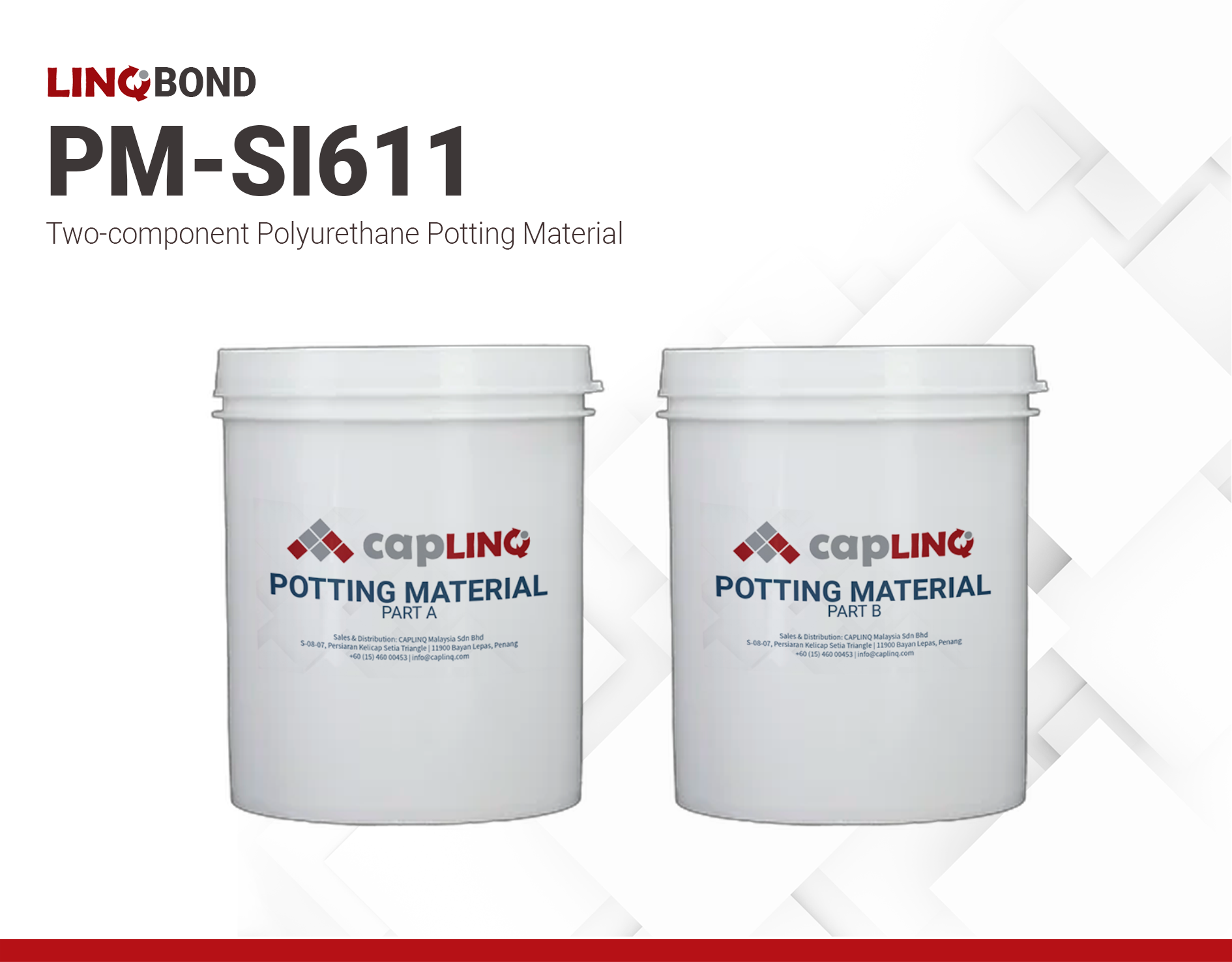PM-SI611 | Silicone Potting material
- High temperature resistance
- High flowability
- Void free casting
Product Description
LINQBOND PM-SI611 is a two-part, grey RTV silicone potting material designed for various applications like electrical potting, PCB encapsulation, LED drivers, cable joining, and surge protection. It offers excellent high-temperature performance and easy reworkability, making it durable and adaptable.
LINQBOND PM-SI611 low viscosity ensures smooth flow, deep penetration, and void-free encapsulation of intricate components. The formula reduces porosity, resulting in strong, reliable castings. Additionally, PM-SI611 has built-in fire-retardant properties, adding safety to critical applications.
Applications:
- Electrical Potting
- PCB Encapsulation
- LED Driver Potting
- Cable Joining
- Surge Protection Device
Product Features & Benefits:
Unmatched High-Temperature Performance & Re-workability: LINQBOND PM-SI611 stands out by offering a rare combination of high-temperature resistance, ensuring reliability in extreme conditions, coupled with excellent re-workability, allowing for easy component repair or replacement, saving time and resources.
Superior Safety & Compliance (UL94 V-0): With its UL94 V-0 flammability rating, this potting material provides an exceptional level of fire safety, exceeding industry standards and ensuring protection for critical applications and peace of mind for users.
Streamlined Processing for High-Volume Manufacturing: The low viscosity and machine pourability of LINQBOND PM-SI611 make it ideal for automated dispensing, facilitating efficient and cost-effective high-volume production while maintaining consistent quality and performance.
Technical Specifications
| General Properties | |
| Mix Ratio Mix Ratio The amount of a constituent divided by the total amount of all other constituents in a mixture | 1:1 |
| Thermal Properties | |
| Operating Temperature | -40 to 200 °C |
| Thermal Conductivity Thermal Conductivity Thermal conductivity describes the ability of a material to conduct heat. It is required by power packages in order to dissipate heat and maintain stable electrical performance. Thermal conductivity units are [W/(m K)] in the SI system and [Btu/(hr ft °F)] in the Imperial system. | >1.0 W/m.K |
| UL 94 Rating UL 94 Rating Flammability rating classification. It determines how fast a material burns or extinguishes once it is ignited. HB: slow burning on a horizontal specimen; burning rate less than 76 mm/min for thickness less than 3 mm or burning stops before 100 mm V-2: burning stops within 30 seconds on a vertical specimen; drips of flaming particles are allowed. V-1: burning stops within 30 seconds on a vertical specimen; drips of particles allowed as long as they are not inflamed. V-0: burning stops within 10 seconds on a vertical specimen; drips of particles allowed as long as they are not inflamed. 5VB: burning stops within 60 seconds on a vertical specimen; no drips allowed; plaque specimens may develop a hole. 5VA: burning stops within 60 seconds on a vertical specimen; no drips allowed; plaque specimens may not develop a hole | V-0 |
| Electrical Properties | |
| Breakdown Voltage Breakdown Voltage Breakdown voltage is the minimum voltage necessary to force an insulator to conduct some amount of electricity. It is the point at which a material ceases to be an insulator and becomes a resistor that conducts electricity at some proportion of the total current. After dielectric breakdown, the material may or may not behave as an insulator any more because of the molecular structure alteration. The current flow tend to create a localised puncture that totally alters the dielectric properties of the material. This electrical property is thickness dependent and is the maximum amount of voltage that a dielectric material can withstand before breaking down. The breakdown voltage is calculated by multiplying the dielectric strength of the material times the thickness of the film. | 24 V |
| Volume Resistivity Volume Resistivity Volume resistivity, also called volume resistance, bulk resistance or bulk resistivity is a thickness dependent measurement of the resistivity of a material perpendicular to the plane of the surface. | 4.2x1013 Ohms⋅cm |
| Chemical Properties | |
| Moisture absorption | 0.2 % |
| Physical Properties | |
| Viscosity Viscosity Viscosity is a measurement of a fluid’s resistance to flow. Viscosity is commonly measured in centiPoise (cP). One cP is defined as the viscosity of water and all other viscosities are derived from this base. MPa is another common unit with a 1:1 conversion to cP. A product like honey would have a much higher viscosity -around 10,000 cPs- compared to water. As a result, honey would flow much slower out of a tipped glass than water would. The viscosity of a material can be decreased with an increase in temperature in order to better suit an application | 2000-3000 mPa.s |
Additional Information
Processing Instructions
Before mixing, stir both Part A and Part B to homogenize.
Mix components A and B according to the specified weight ratio. Stir thoroughly to ensure uniformity while preventing air from introduced into the mixture. Ensure contamination is avoided.
To ensure complete mixing of both parts, machine mixing and dispensing are recommended. Static and dynamic mixer can also be used for mixing.
Degas the mixture to remove the bubbles for about 10 minutes. Do not fill the container more than half full to prevent overflowing during degassing.
Gradually pour the mixed compound into the device being potted.
Allow the potted workpiece to cure. The curing process is influenced by temperature variations; generally, higher temperatures result in faster curing, while lower temperatures lead to slower curing.
Packaging
LINQBONDTM PM-SI611 Part A and Part B is available in 30 kg open top plastic buckets.
Storage and Handling
Store in a ventilated, dry, and clean environment at 30±5 °C. Keep away from fire and heat sources. It is strictly forbidden to store in outdoor environments. At proper storage conditions, both Part A and Part B have a shelf life of 6 months.



